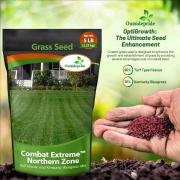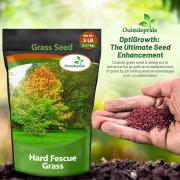Although tall fescue tolerates low fertility, it responds to fertilization, particularly nitrogen. About 3 lbs. of actual nitrogen per 1,000 sq. ft. per year is adequate. Apply a complete fertilizer according to soil test recommendations in the fall (September) and late spring (May) at a rate of 1 lb. of actual nitrogen per 1,000 sq. ft. Apply nitrogen alone at the same rate in February when the grass is actively growing. A summer application of 0.5 lb. of actual nitrogen per 1,000 sq. ft. may improve the color of the lawn. However, avoid overstimulation of the turf during summer months from excessive fertilization as this only adds to heat and drought stress problems. In shaded lawns, avoid summer applications of nitrogen.
Mow tall fescue at 2 inches during the fall and spring, raise to 3 inches in heavy shade and during the heat of the summer months. The improved turf-type varieties of tall fescue (which is what we carry) can be mowed at a height of 1.5 inches during spring and fall and 2 inches during summer months. Use a sharp rotary or reel mower and remove only one third of the leaf material per mowing. During peak spring and fall growth periods this requires mowing at 5-day intervals. If the lawn is mowed at the proper height and frequency, it is not necessary to remove grass clippings. For more details go here: Fescue Grass Information



































